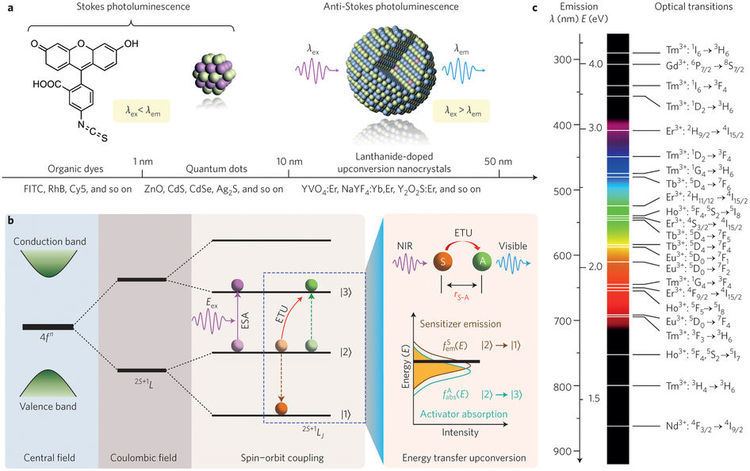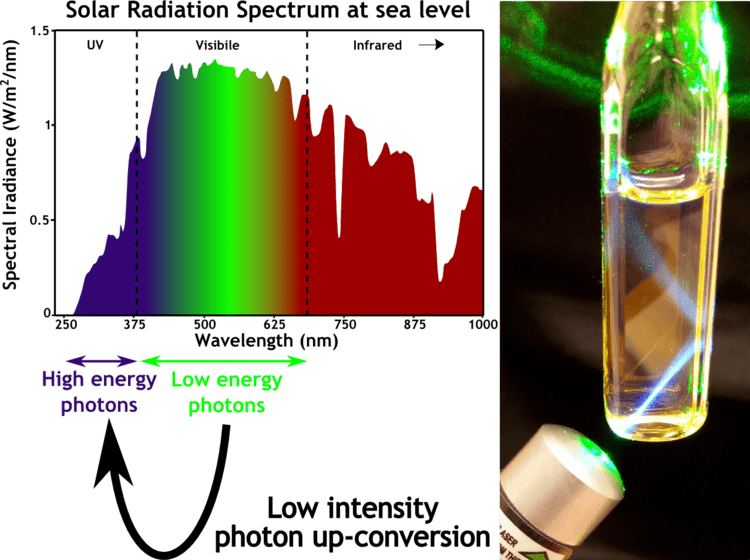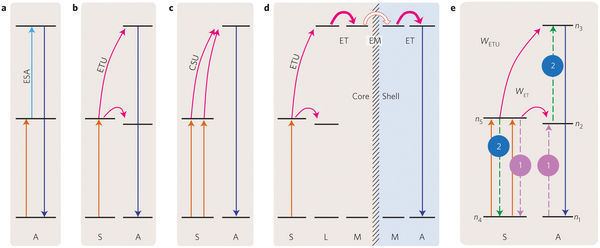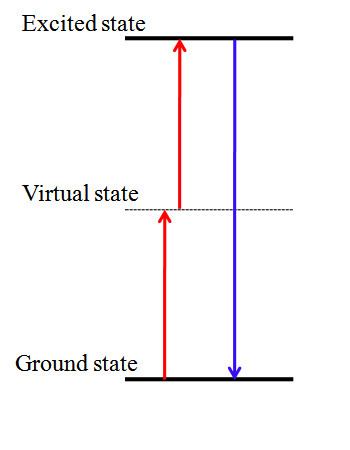 | ||
Photon upconversion (UC) is a process in which the sequential absorption of two or more photons leads to the emission of light at shorter wavelength than the excitation wavelength. It is an anti-Stokes type emission. An example is the conversion of infrared light to visible light. Materials by which upconversion can take place often contain ions of d-block or f-block elements. Examples of these ions are Ln3+, Ti2+, Ni2+, Mo3+, Re4+, Os4+, and so on.
Contents
- Prototype photon upconversion devices
- Physical mechanisms behind photon upconversion
- Upconverting nanoparticles
- Lanthanide doped nanoparticles
- Semiconductor nanoparticles
- Upconversion Nanocapsules for Differential Cancer Bioimaging in vivo
- References

Prototype photon upconversion devices
Physical mechanisms behind photon upconversion
Three basic mechanisms can contribute to photon upconversion: energy transfer upconversion (ETU), excited-state absorption (ESA) and photon avalanche (PA). Such processes can be observed in materials with very different sizes and structures, including optical fibers, bulk crystals or nanoparticles, as long as they contain any of the active ions mentioned above. Upconversion should be distinguished from two-photon absorption and second-harmonic generation. These two physical processes have a similar outcome than photon upconversion (emission of photons of shorter wavelength that the excitation) but the mechanism behind is different. An early proposal (a solid-state IR quantum counter) was made by N. Bloembergen in 1959 and the process was first observed by F. Auzel in 1966.

Thermal upconversion mechanism has also been proposed. This mechanism is based on the absorption of photons with low energies in the upconverter, which heats up and re-emits photons with higher energies. To make this process possible, the density of optical states of the upconverter has to be carefully engineered to provide frequency- and angularly-selective emission characteristics. For example, a planar thermal upconverting platform can have a front surface that absorbs low-energy photons incident within a narrow angular range, and a back surface that efficiently emits only high-energy photons. These surface properties can be realized through designs of photonic crystal, and theories and experiments have been demonstrated on thermophotovoltaics and radiation cooling. Under best criterion, energy conversion efficiency from solar radiation to electricity by introducing up-converter can go up to 73% using AM1.5D spectrum and 76% considering sun as a black body source at 6000K for a single junction cell.
Upconverting nanoparticles

Although photon upconversion was first studied in bulk crystals and optical fibers, it became better known with the development of nanomaterials. This happened due to the many ways in which nanostructures with photon upconversion properties can be applied. This new class of materials may broadly be referred to as Upconverting Nanoparticles or UCNPs.
Lanthanide-doped nanoparticles

Lanthanide-doped nanoparticles emerged in the late 1990s due to the prevalent work on nanotechnology, marking a turning point in the landscape of modern lanthanide research. Although the optical transitions in lanthanide-doped nanoparticles essentially resemble those in bulk materials, the nanostructure amenable to surface modifications provides new opportunities for research. Besides, the small size of the particles allow their use as alternatives to molecular fluorophores for biological applications. Their unique optical properties, such as large Stokes shift and nonblinking, have enabled them to rival conventional luminescent probes in challenging tasks including single-molecule tracking and deep tissue imaging. In the case of bioimaging, as lanthanide-doped nanoparticles can be excited with near-infrared light, they are optimal to reduce autofluorescence of biological samples and thus, improve the contrast of the image.

Lanthanide-doped nanoparticles are nanocrystals of a transparent material (more often the fluorides NaYF4, NaGdF4, LiYF4, YF3, CaF2 or oxides such as Gd2O3) doped with certain amounts of lanthanide ions. The most common lanthanide ions used in photon upconversion are the pairs erbium-ytterbium (Er3+,Yb3+) or thulium-ytterbium (Tm3+, Yb3+). In such combinations ytterbium ions are added as antennas, to absorb light at around 980 nm and transfer it to the upconverter ion. If this ion is erbium, then a characteristic green and red emission is observed, while when the upconverter ion is thulium, the emission includes near-ultraviolet, blue and red light.
Despite the promising aspects of these nanomaterials, one urgent task that confronts materials chemists lies in the synthesis of nanoparticles with tunable emissions, which are essential for applications in multiplexed imaging and sensing. The development of a reproducible, high yield synthetic route that allows controlled growth of rare earth halide nanoparticles has enabled the development and commercialization of upconversion nanoparticles in many different bioapplications. The first worldwide, commercially available upconversion nanoparticles were developed by Intelligent Material Solutions, Inc. and distributed through Sigma-Aldrich. Recently, moving forward in the challenge of designing particles with tunable emissions, important progress in synthesis of high-quality nano-structured crystals has enabled new pathways for photon upconversion. This includes the possibility of creating particles with core/shell structures, allowing upconversion through interfacial energy transfer (IET).
Semiconductor nanoparticles
Semiconductor nanoparticles or quantum dots have often been demonstrated to emit light of shorter wavelength than the excitation following a two-photon absorption mechanism, not photon upconversion. However, recently the use of semiconductor nanoparticles, such as CdSe, PbS and PbSe combined with molecular emitters has been shown as a new strategy for photon upconversion through triplet-triplet annihilation. They are being used to upconvert 980 nm infrared light to 600 nm visible light. This technique benefits from a very high upconverting capability. Especially, these materials can be used to capture the infrared region of sunlight to electricity and enhance the efficiency of photovoltaic solar cells.
Upconversion Nanocapsules for Differential Cancer Bioimaging in vivo
Early diagnosis of tumor malignancy is crucial for timely cancer treatment aimed at imparting desired clinical outcomes. The traditional fluorescence-based imaging is unfortunately faced with challenges such as low tissue penetration and background autofluorescence. Upconversion (UC)-based bioimaging can overcome these limitations as their excitation occurs at lower frequencies and the emission at higher frequencies. Recently, Kwon et al. developed multifunctional silica-based nanocapsules, synthesized to encapsulate two distinct triplet-triplet annihilation UC chromophore pairs. Each nanocapsule emits different colors, blue or green, following a red light excitation. These nanocapsules were further conjugated with either antibodies or peptides to selectively target breast or colon cancer cells, respectively. Both in vitro and in vivo experimental results demonstrated cancer-specific and differential-color imaging from single wavelength excitation as well as far greater accumulation at targeted tumor sites than that due to the enhanced permeability and retention effect. This approach can be used to host a variety of chromophore pairs for various tumor-specific, color-coding scenarios and can be employed for diagnosis of a wide range of cancer types within the heterogeneous tumor microenvironment.
